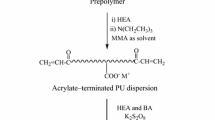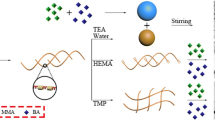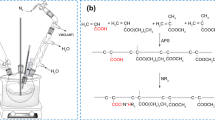Abstract
Two-component waterborne polyurethane (2K WBPU) coatings were prepared using a silicone-modified acrylic emulsion as the hydroxyl component, and hydrophilically-modified polyisocyanate as the curing agent. The effects of the levels of silicone monomer and hydroxyl values on the film properties of the 2K WBPU coatings were investigated. Infrared spectroscopy characterized its structure. Scanning electron microscopy (SEM), thermo-gravimetric analysis (TGA), and differential scanning calorimetry (DSC) were used to study the surface morphology and the thermal stability of the film. The results showed that the performance of the coatings and the thermal stability of the film of 2K WBPU were improved after silicone modification.
Similar content being viewed by others
Explore related subjects
Discover the latest articles, news and stories from top researchers in related subjects.Avoid common mistakes on your manuscript.
Introduction
waterborne polyurethane paints have the merits of being non-toxic, odorless, safe to use and present no harm to the environment, and therefore are now replacing traditional solvent-based paints. Two-component waterborne polyurethane paints (2K WBPU) have almost the same properties as solvent-based paint. These are good abrasion resistance, hardness and flexibility, and good chemical and solvent resistance. Above all, 2K WBPU offer a significant reduction over solventborne systems in terms of emissions of volatile organic compounds (VOCs) and hazardous air pollutants (HAPs), meeting stringent environment regulations. As a result, they have attracted much interest in the world.1 Denise et al.2 examined the effect of particle-size distribution on the performance of two-component water-reducible acrylic polyurethanes; Sharon et al.3 examined the effect of additives on the performance of 2K WBPU coatings; and David et al.4 optimized acrylic polyols for 2K WBPU coatings using tertiary isocyanate as crosslinkers. Nabuurs et al.5 investigated the acid monomer and acid value in the acrylic dispersions used in 2K WBPU coatings, and obtained defect-free coatings.
Recently, Wicks et al.6 reviewed two package waterborne urethane systems, including paints and coatings. This indicated that the 2K WBPU coating could be used as automotive coatings, wood finishes, maintenance and plastic coatings, in fact, many papers placed the major emphasis on wood coatings. Michael7 looked at the differences between solventborne polyurethane and waterborne wood coatings. Sharon et al.8 used statistical methods to develop hydroxyl functional acrylic emulsions and to prepare 2K WBPU coatings for use in kitchen cabinet and office furniture applications. Sonntag discussed 2K WBPU coatings used for automotive, automotive refinishing and commercial vehicles.9 For these end-uses, the water and chemical resistance are very important. Until now, however, few papers have concentrated on the water and chemical resistance properties of 2K WBPU coatings. Traditionally, these coatings have had poor water and chemical resistance compared with traditional solvent-based versions. In addition, the properties of 2K WBPU coatings still need to be improved. The authors of this paper10 have prepared silicone-modified acrylic emulsions (SAE) with high hydroxyl contents, which may be used in 2K WBPU coatings. The aim of this paper was to investigate the effect of the SAE on the water, chemical, and mechanical properties of 2K WBPU coatings. The surface morphology and film thermal resistance were also investigated.
Experimental
Materials
Silicone-modified acrylic emulsions with different hydroxyl values and silicone-monomer contents were prepared according to the literature,10 which described a solid content of 40% and a designed theoretical glass transition temperature of 10°C. The hydrophilic-modified polyisocyanate used was Rhodocoat WT2102 (Rhodia)—solid content, 100%; viscosity, 4300 MPa s; –NCO content (as supplied), 19%; free monomer, <0.2%. The defoamer BYK028 and the leveling agent BYK346 were both from BYK Co. in Germany.
Coating formulation
The acrylic emulsion was crosslinked with Rhodocoat WT2102. The Rhodocoat WT2102 was diluted to 90% solid content with butyl acetate before use. The defoamer and the leveling agent were first added to the acrylic emulsion (all at 0.01%, based on the weight of the acrylic emulsion), then the crosslinker was stirred into the acrylic emulsions and water was added when necessary. Finally, this was stirred for another 10 min before the films were made. The coatings were brushed onto clean glass panels and sand-treated thin tinplate panels, and then dried at 23°C. The thickness of the dry film was kept at 20 μm ± 3 μm. The gloss, adhesion, flexibility, and impact resistance were measured after the panel was dried for 48 h, and the pencil hardness was measured after 48 h and 7 days, respectively. The water and chemical resistance were determined after 7 days.
Coating test procedures
Dry times were determined using an automatic drying time recorder on the glass panel (ASTM D711); gloss was read directly at 60° on the glass panel using a glossmeter (ISO 2813); the hardness was tested with a pencil having a different hardness on a glass panel (ASTM D2197); the adhesion was tested using the cross-hatch method at a distance of 1 mm on tinplate (ISO 2409); the flexibility was tested with a T-bend tester (ISO 1519); and impact resistance was measured with an impact tester on tinplate (ISO 6272). The water resistance was determined as follows:
-
1.
The edge and back of the coated tinplate were brushed with the mixture composed of 1:1 weight rosin and paraffin.
-
2.
Two-thirds of the panel was dipped in water and lifted out at regular intervals.
-
3.
The panel was evaluated after sucking the water off with paper.
The chemical resistance was determined as follows: reagents were placed on glass panel surfaces where they formed liquid drops for 24 h before evaluation.
Characterization
The infrared (IR) spectra were recorded with a Nicolet NEXUS 470 FTIR instrument in the 400–4000 cm−1 region. An acrylic emulsion and a mixed 2K WBPU paint were coated directly on to the surface of a KBr crystal, respectively, and measured after film forming and drying (a simple IR measurement method for liquid sample). The surface of the paint film was observed with a Hitachi SEM S-570 scanning electron microscope (SEM). The thermo-gravimetric and differential scanning calorimetric (TG-DSC) analyses were conducted with a Netzsch STA 449C synthesis thermo-analyzer under a nitrogen atmosphere using a heating rate of 10°C per minute, rising from room temperature to 600°C.
Results and discussion
Effect of hydroxyl value of SAE
When the acid and silicone monomer content of the SAE were all fixed at 3%, a series of two-component polyurethane coatings were prepared using SAE with different hydroxyl values and Rhodocoat WT 2102 as the crosslinking agent at an –NCO/OH ratio of 1.5:1. The properties are shown in Table 1.
From Table 1, it is shown that the film performances of these paints were good, except for the fail result in the 10% NaOH-resistance test. When the hydroxyl value (all quoted in mg KOH/g) of the SAE was reduced from 125 to 50, the touch-dry time increased gradually from 4 to 15 h, the gloss increased from 26 to 125, and the pencil hardness was good. The flexibility, adhesion, and impact resistance values were the best obtained, while the chemical resistance of the resulting film was the highest obtained. The properties of the film were improved except for the 10% NaOH resistance compared to the coating without any silicone modification.11 The water resistance of the film was also improved, with a decrease in the hydroxyl value of the emulsion. The reason for this was that the acrylic emulsion with the lower number of hydroxyl groups had a lower hydrophilicity, which was about the same as the hydrophilic-modified polyisocyanate. As a result, it had better compatibility with the polyisocyanate and could completely react with –NCO groups. The acrylic emulsion with the higher hydroxyl values had residual hydroxyl groups that decreased the water resistance. The silicone-modified acrylic emulsion had better water and chemical resistance than the acrylic emulsion due to its lower surface tension, which hindered the contact with water and chemicals. Thus, the coatings prepared with SAE also had better water and chemical resistance.
Level of silicone monomer in SAE
A series of 2K WBPU coatings were prepared at an –NCO/OH ratio of 1.5:1. The level of acrylic acid monomer in the emulsion composite was fixed at 3%; the hydroxyl value of SAE was fixed at 100 mgKOH/g, but different silicone monomer levels were used in the acrylic emulsion. The properties of this series are shown in Table 2.
It is demonstrated in Table 2 that when the acrylic emulsion was modified with the silicone monomer, the water and chemical resistance of the resulting coating film were improved. Other properties were also good, but again, the alkali-resistance was bad. A higher level of silicone monomer did not significantly influence the coating properties, except for the touch-dry time. Therefore, a small level of silicone monomer may be enough for this system. The silicone monomer moiety is apt to locate at the surface of the emulsion particle due to its low-surface tension. After the hydroxyl groups had reacted with the hydrophilic-modified polyisocyanate, it also moved to the surface of the resulting film—improving the water and chemical resistance.
IR spectrum of 2K PU film
The IR spectrum of SAE with silicone monomer 3%, a hydroxyl value of 100 mgKOH/g, and the IR spectrum of 2K WBPU film were prepared from the above emulsion and Rhodocoat WT2102 with an –NCO/OH ratio = 1.5 and are shown in Fig. 1.
It can been seen from Fig. 1(a) that there are strong absorption peaks at 3530 cm−1, 2958 cm−1, 2875 cm−1, and 1740 cm−1, which are ascribed to the vibration of –OH, –CH3, –CH2 and C=O, respectively. There are no absorption peaks at 1613 cm−1 and 3012 cm−1, which indicates that no C=C bond existed in the three emulsion polymers and therefore all the monomers were polymerized.
After crosslinking (see Fig. 1(b)), the wide and strong –OH absorptions between 3444 cm−1 and 3533 cm−1 disappeared and a new sharp peak appeared at 3353 cm−1, which was attributed to N–H absorption. A shoulder peak still existed at about 3540 cm−1, which was a sign that some –OH groups had not reacted. The NCO absorption peak at 2273 cm−1 did not appear, indicating that the –NCO group had reacted completely. A new stronger peak at 1689 cm−1 was attributed to C=O stretch vibration, which meant that a reaction between water and –NCO took place. The absorption peak at 1563 cm−1 was attributed to N–H bond vibration and C–N symmetry stretch vibration, and the sharp and strong peak at 761 cm−1 was absorption due to C–N bond vibration. These indicated the presence of urethane bond and urea bond formation. A new peak appeared at 1168 cm−1 that was attributed to the C–N–C stretch vibration in the isocyanurate ring in the hydrophilic-modified curing agent.
SEM morphology of 2K WBPU coatings
Two SEM photographs of 2K WBPU coatings consisting of SAE and hydrophilic-modified polyisocyanate Rhodocoat WT2102 with an NCO/OH ratio of 1.5 are shown in Fig. 2. It can be seen from these SEM photographs at different magnifications that some white particles still existed at the surface of the film, some of which were connected together. These were acrylic emulsion particles that had not reacted with the curing agent. They were connected together due to the formation of hydrogen bonds between the OH groups in the acrylic emulsion. Still, some hydrophilic-modified polyisocyanate particles may also have existed that were not well-dispersed in the coating film.
TG-DSC analysis
Figure 3 illustrates the TG-DSC curves of SAE (a), the 2K WBPU coating film consisting of SAE and curing agent Rhodocoat WT 2102 (b), the 2K WBPU coating film composed of the commonly used acrylic emulsion and curing agent Rhodocoat WT 2102(c), when NCO/OH = 1.5:1. Figure 3(a) shows that the SAE had only one endothermic peak at 354–427°C, and the major decomposition temperature was 389.2°C. Figure 3(b) shows that the film began to decompose at 82°C due to water and solvent volatilization, with a total weight loss of about 2.75%. The second endothermic peak was from 210 to 329.4°C, and the major decomposition temperature was 326.6°C with a weight loss of about 14.72%. This corresponded with the decomposition of the urea formed by water and polyisocyanate. The third endothermic peak was from 374.2 to 430.5°C, and the major decomposition temperature was 404.7°C with a weight loss of about 36.75%. This corresponded with the decomposition of the unreacted acrylic emulsion polymer (i.e., the same temperature as the major decomposition temperature in Fig. 3(a)). The fourth endothermic peak began at 445.8°C and ended at 497.9°C. The major decomposition temperature was 469.7°C, with a weight loss of about 39.17%. This corresponded with the decomposition of the urethane bonds formed by interaction of the OH groups and the NCO groups. The TG-DSC results revealed that some SAE reacted with the polyisocyanate to form urethane bonds, but still some molecules had not reacted. It also indicated that the coatings film composed of SAE and a curing agent had a higher-decomposition temperature than that composed of a traditional acrylic emulsion and a curing agent. This suggests the modification of the acrylic emulsion improved the thermal decomposition temperature. This was consistent with the IR results.
Conclusions
Silicone-modified acrylic emulsions with hydroxyl groups may be used as the hydroxyl component for two-component waterborne polyurethane coatings. The hydroxyl value of the emulsion and the level of silicone monomer had an important effect on the properties of these coatings. IR, SEM, and TG-DSC results revealed that some of the emulsion polymer had reacted with polyisocyanate to form polyurethane, but also revealed that some molecules had not reacted. The silicone modification of the acrylic emulsion improved the properties of the resultant 2K WBPU paint.
References
Melchiors M, C Kobusch, E Jurgens, M Sonntag, Recent Developments in Aqueous Two-Component Polyurethane (2K-PUR) Coatings, Prog. Org. Coat., 40 (1–4), 99–109, 2000
Denise EF, AL David, JQ Richard, Effect of Particle-Size Distribution on the Performance of Two-Component, Water-Reducible Acrylic Polyurethane Coatings Using Tertiary Polyisocyanate Cross-Linkers, J. Coat. Technol., 72 (902), 63–69, 2000
Sharon XD, L Phil, R Wargo, Effects of Additives on Performance of Two-Component Water-Borne Polyurethane Coatings, J. Coat. Technol., 71, (897), 143–149, 1999
David LA, JQ Richard, EF Denise, Optimization of Acrylic Polyols for Low VOC Two-Component Water-Reducible Polyurethane Coatings Using Tertiary Isocyanate Cross-Linkers, Prog. Org. Coat., 35 (1–4), 109–116, 1999
Nabuurs T, D Pears, A Overbeek, Defect-Free Coatings From Two-Pack Isocyanate Curable Acrylic Dispersions, Prog. Org. Coat., 35 (1–4), 129–140, 1999
Wicks ZW, AW Douglas, WR James, Two Package Water-Borne Urethane Systems, Prog. Org. Coat., 44 (2), 161–183, 2002
Michael JD, Using High-Performance Two-Component Water-Borne Polyurethane Wood Coatings, J. Coat. Technol., 69 (866), 47–52, 1997
Sharon XD, M Dvorchak, KE Hudson, C Renk, New High-Performance Two-Component Wood Coatings Comprised of a Hydroxy-Functional Acrylic Emulsion and a Water-Dispersible Polyisocyanate, J. Coat. Technol., 71 (899), 51–57, 1999
Sonntag M, Aqueous Two-Pack Polyurethane (2K-PUR) Coatings for Automotive Refinish and Commercial Vehicles, Surface Coat. Intl., 82 (9), 456–459, 1999
Zhang, FA, Wang, YP, Chai, CP, “Synthesis and Characterization of Silicone-Modified Acrylic Emulsion Containing High Hydroxyl Contents.” Proc. Intl Water-Borne, High-Solids and Powder Coatings Symposium, pp. 516–524, New Orleans, LA, USA, February 2004
Zhang, FA, Yu, CL, Wang, YP, “Application of Acrylic Emulsion Containing Hydroxyl Groups in Two-Component Waterborne Polyurethane Coatings.” Paint Coat. Industry (in Chinese), 36 (5) 5–8 (2006)
Acknowledgments
The authors would like to thank the Doctors’ Fund of Guilin University of Technology and the fund of the Education Bureau of Guangxi Province (200508041).
Author information
Authors and Affiliations
Corresponding author
Rights and permissions
About this article
Cite this article
Zhang, FA., Yu, CL. Application of a silicone-modified acrylic emulsion in two-component waterborne polyurethane coatings. J Coat Technol Res 4, 289–294 (2007). https://doi.org/10.1007/s11998-007-9045-9
Published:
Issue Date:
DOI: https://doi.org/10.1007/s11998-007-9045-9







